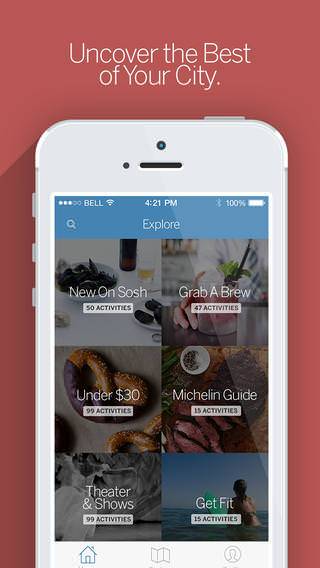Uprooting your life to start anew can be daunting. I came to San Francisco without a plan or place to live, and, after traveling to the city just once before I made a decision to move, the unfamiliarity was mildly uncomfortable. Which is why I relied on my iPhone to help me navigate the San Francisco hills and slowly become a Bay Area local.
From finding an apartment to making new friends, mobile devices can be the best way to connect with and discover cities around the world. I used all these apps exclusively on my Apple device, but most are available on Android, too, unless stated otherwise.
Do I Really Want To Live Here?
Before solidifying my California residency, I took a couple trips getting to know San Francisco and the quirks in various parts of the city. I found out quickly which neighborhoods I would like to live in, and which to avoid.
See Also: I Was An Airbnb Hotel Tenant
But instead of staying in hotels or traditional bed and breakfasts that cater to tourists, I used Airbnb. The Airbnb application lets users rent rooms or apartments from hosts who own the properties. While many people lament the quality of Airbnb digs—a closet-turned-bedroom isn’t that comfortable—the service helped me get a feel for the neighborhood without committing to a one-year lease.
Of course, there’s more to loving your neighborhood than just having a great apartment. Community discovery applications like Yelp and Foursquare provided suggestions for local hangouts for eating, drinking and exploring.
Foursquare recently updated its app to help users better discover new areas. It now pushes recommendations based on your location and previous check-ins—for instance, when your flight lands in Portland, you could get a notification containing the top restaurants in the area.
Finding A Home

As anyone who has moved to San Francisco knows, finding an apartment is almost impossible. I imagine it’s equally stressful in any big city, especially when you have specific criterion that need to be fulfilled.
It’s a good thing there’s an app for that.
Enter Lovely, the mobile application that makes it easy for renters to find their home. Lovely aggregates rental postings from around the Internet, including pulling listings from Craigslist. Lovely places them on an interactive map so you can immediately see where the rental is located, a list of apartment details, and view photos directly in the app. You can also set push notifications to be alerted when there is an available apartment in a desirable area.
I relied entirely on Lovely to find my apartment, but there are other services like Trulia and Craigslist Pro that can help with your search. And if you’re looking to furnish your new space with inexpensive furniture, Ikea’s augmented reality application can help you decide what furniture and home accessories look great and fit right in your living room.
Getting Around
After finally settling into my new apartment, my next challenge was figuring out how to get around. In many urban areas, residents rely on public transportation, or car services like Uber or Lyft—though you will rack up a hefty tab.
Google Maps has its own public transit directions, but if you prefer a separate application—and sometimes a more reliable service—there are a number of transit apps that can plan your trip.
NextBus, a Web-based application that’s optimized for mobile devices, delivers real-time transit information for cities across the country. Unlike Google’s transit data, NextBus regularly updates arrival information and changes arrival times when the buses fall behind. In New York and London, City Mapper is the ultimate transportation app, providing information on trains, buses and bike routes. And the iOS application Smart Ride available in a number of metropolitan areas around the world delivers up-to-date arrival alerts to improve your commute.
If you’re like me and sometimes need personal wheels, Zipcar can provide them. With Zipcar, you can rent a car via a mobile device and pick one up wherever is convenient. Using your smartphone and a card that unlocks the vehicle, you can be up and driving within minutes. Additionally, affordable prices make an occasional Zipcar much cheaper than upkeep on your own vehicle.
A New Social Life
Here’s secret no one tells you about getting older: It’s really tough to make friends.
When I needed to create a new social circle, Twitter was my lifesaver. It was easy to reach out to strangers and begin to have spontaneous conversations about San Francisco, technology and the Bay Area’s best nightlife in just 140 characters. Eventually, the group of friends I built on the service became friends offline, too.

There’s a new trend overtaking personal relationships—meeting each other online. It’s no longer considered “weird” to have met your partner on the Internet. Dating applications like Tinder, OkCupid, and Grindr take the awkward out of ice breakers and open up new opportunities to meet potential suitors.
I quickly found out I wasn’t the only transplant in San Francisco looking to grow my social group. Sosh came highly recommended—the iOS and Web app available now in San Francisco and New York, and soon to be available in Chicago, Boston, Los Angeles, and Seattle, is an event and activity discovery app that lets you source ideas from friends and tastemakers in the city. And Nextdoor, a private social network exclusive to your neighborhood in a select geographic area, is an easy way to get to know your neighbors as well as keep your home and community safe.
Thanks to the handful of apps in the “social” bucket on my iPhone, my network of friends slowly grew.
And they helped me fall in love with the city I now call home.
















